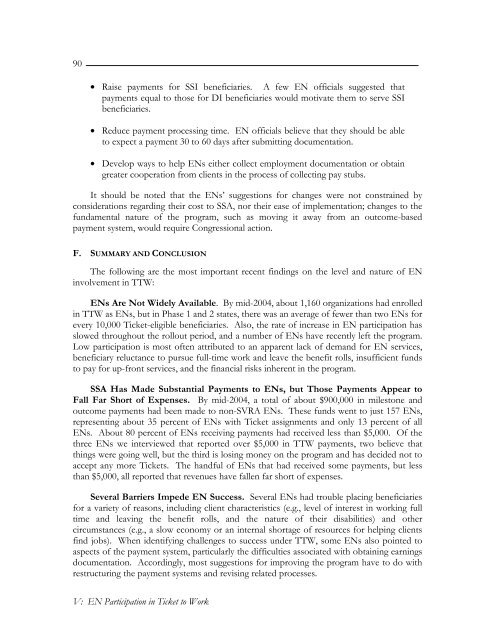Evaluation of the Ticket to Work Program, Implementation ...
Evaluation of the Ticket to Work Program, Implementation ...
Evaluation of the Ticket to Work Program, Implementation ...
You also want an ePaper? Increase the reach of your titles
YUMPU automatically turns print PDFs into web optimized ePapers that Google loves.
90• Raise payments for SSI beneficiaries. A few EN <strong>of</strong>ficials suggested thatpayments equal <strong>to</strong> those for DI beneficiaries would motivate <strong>the</strong>m <strong>to</strong> serve SSIbeneficiaries.• Reduce payment processing time. EN <strong>of</strong>ficials believe that <strong>the</strong>y should be able<strong>to</strong> expect a payment 30 <strong>to</strong> 60 days after submitting documentation.• Develop ways <strong>to</strong> help ENs ei<strong>the</strong>r collect employment documentation or obtaingreater cooperation from clients in <strong>the</strong> process <strong>of</strong> collecting pay stubs.It should be noted that <strong>the</strong> ENs’ suggestions for changes were not constrained byconsiderations regarding <strong>the</strong>ir cost <strong>to</strong> SSA, nor <strong>the</strong>ir ease <strong>of</strong> implementation; changes <strong>to</strong> <strong>the</strong>fundamental nature <strong>of</strong> <strong>the</strong> program, such as moving it away from an outcome-basedpayment system, would require Congressional action.F. SUMMARY AND CONCLUSIONThe following are <strong>the</strong> most important recent findings on <strong>the</strong> level and nature <strong>of</strong> ENinvolvement in TTW:ENs Are Not Widely Available. By mid-2004, about 1,160 organizations had enrolledin TTW as ENs, but in Phase 1 and 2 states, <strong>the</strong>re was an average <strong>of</strong> fewer than two ENs forevery 10,000 <strong>Ticket</strong>-eligible beneficiaries. Also, <strong>the</strong> rate <strong>of</strong> increase in EN participation hasslowed throughout <strong>the</strong> rollout period, and a number <strong>of</strong> ENs have recently left <strong>the</strong> program.Low participation is most <strong>of</strong>ten attributed <strong>to</strong> an apparent lack <strong>of</strong> demand for EN services,beneficiary reluctance <strong>to</strong> pursue full-time work and leave <strong>the</strong> benefit rolls, insufficient funds<strong>to</strong> pay for up-front services, and <strong>the</strong> financial risks inherent in <strong>the</strong> program.SSA Has Made Substantial Payments <strong>to</strong> ENs, but Those Payments Appear <strong>to</strong>Fall Far Short <strong>of</strong> Expenses. By mid-2004, a <strong>to</strong>tal <strong>of</strong> about $900,000 in miles<strong>to</strong>ne andoutcome payments had been made <strong>to</strong> non-SVRA ENs. These funds went <strong>to</strong> just 157 ENs,representing about 35 percent <strong>of</strong> ENs with <strong>Ticket</strong> assignments and only 13 percent <strong>of</strong> allENs. About 80 percent <strong>of</strong> ENs receiving payments had received less than $5,000. Of <strong>the</strong>three ENs we interviewed that reported over $5,000 in TTW payments, two believe thatthings were going well, but <strong>the</strong> third is losing money on <strong>the</strong> program and has decided not <strong>to</strong>accept any more <strong>Ticket</strong>s. The handful <strong>of</strong> ENs that had received some payments, but lessthan $5,000, all reported that revenues have fallen far short <strong>of</strong> expenses.Several Barriers Impede EN Success. Several ENs had trouble placing beneficiariesfor a variety <strong>of</strong> reasons, including client characteristics (e.g., level <strong>of</strong> interest in working fulltime and leaving <strong>the</strong> benefit rolls, and <strong>the</strong> nature <strong>of</strong> <strong>the</strong>ir disabilities) and o<strong>the</strong>rcircumstances (e.g., a slow economy or an internal shortage <strong>of</strong> resources for helping clientsfind jobs). When identifying challenges <strong>to</strong> success under TTW, some ENs also pointed <strong>to</strong>aspects <strong>of</strong> <strong>the</strong> payment system, particularly <strong>the</strong> difficulties associated with obtaining earningsdocumentation. Accordingly, most suggestions for improving <strong>the</strong> program have <strong>to</strong> do withrestructuring <strong>the</strong> payment systems and revising related processes.V: EN Participation in <strong>Ticket</strong> <strong>to</strong> <strong>Work</strong>
















